![]()
![]()
![]()
Use LEFT and RIGHT arrow keys to navigate between flashcards;
Use UP and DOWN arrow keys to flip the card;
H to show hint;
A reads text to speech;
61 Cards in this Set
- Front
- Back
|
Setback |

In land use, a setback is the distance which a building or other structure is set back from any place which is deemed to need protection. |
|
|
Easement |
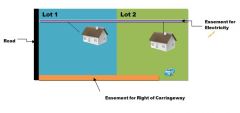
A defined portion of a lot, tract or parcel reserved for use by someone other than the property owner. Uses can include access, utilities, or parking by another party who holds the easement interest or easement rights. |
|
|
Covenant |

An agreement, especially by lease, deed, or other legal contract. |
|
|
Right of Way |

Origin carriageway, applies to the form of ownership of a street or road. Specifically, it is the legal right, established by usage or grant, to pass along a specific route through grounds or property belonging to another. |
|
|
Sight Line Triangle |
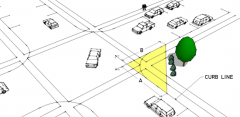
A setback that restricts anyone from putting view obstructions at the height of drivers sight. |
|
|
Malfeasance |
Refers to an erroneous professional action taken by a public official. |
|
|
Land Use |
Land use is the human use of land. Land use involves the management and modification of natural environment or wilderness into built environment such as settlements and semi-natural habitats such as arable fields, pastures, and managed woods. |
|
|
Land Use Classifications |
A classification providing information on land cover, and the types of human activity involved in land use. It may also facilitate the assessment of environmental impacts on, and potential or alternative uses of, land. |
|
|
Land Use Plan |
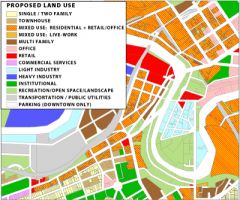
The proposed utilization of land, resulting from planning and zoning studies. |
|
|
Zoning Ordinances |
Written regulations and laws that define how property in specific geographic zones can be used. Specify whether zones can be used for residential or commercial purposes, and may also regulate lot size, placement, bulk (or density) and the height of structures. |
|
|
Nonconforming Use |
A use of land or bldng that was lawful until new zoning was applied and is which is permitted to continue. |
|
|
Nondiscretionary Standards |
Criteria which indicate a measurable numeric standard that must be met in order to get zoning approval. (not an option to do this, ex. setbacks - anyone can measure distance to determine if bldng complies) |
|
|
Planned Unit Development |
A PUD is a flexible zoning technique that allows developer much more creativity in how land is utilized w/o sacrificing public concerns for compatibility with adjacent uses of land and often with greater protection of environmental features. |
|
|
Comprehensive Planning or Master Plan |
A term used by land use planners or planning commission to describe a process that determines community goals and aspirations in terms of community development. The outcome of comprehensive planning is the Comprehensive Plan which dictates public policy in terms of transportation, utilities, land use, recreation, and housing. Comprehensive plans typically encompass large geographical areas, a broad range of topics, and cover a long-term time horizon. |
|
|
Transfer of Development Rights |
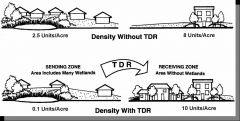
A program or an agreement for relocation of residential density, possibly including the right to transfer development offsite to another property. |
|
|
Capital Improvement Plan |
A CIP, identifies capital projects and equipment purchases, provides a planning schedule and identifies options for financing the plan. Essentially, the plan provides a link between a municipality, school district, parks and recreation department and/or other local government entity and a comprehensive and strategic plans and the entity's annual budget. |
|
|
Subdivision Regulations |
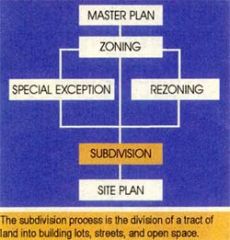
Used to control the intensity of a proposed development by limiting the site's size, location, proximity to other uses, density and coverage. |
|
|
Lot Coverage Limits |
Used to control size of building or pavement coverage in relation to total site size. The extent of the coverage (10% - 90%) is considered the land use intensity. |
|
|
Variance Process |
Used to formally acknowledge and address lot sizes or shape variation in relation to other similarly designated lots. |
|
|
Shortlist |
A method of prequalifying a small number of firms with proven capabilities to execute a project. |
|
|
Request for Proposals |
A RFP requests that consultants submit a “proposal” about how they would approach the work. In evaluating an RFP, one of the evaluation criteria should be an evaluation of the proposal and how creative it is and how closely it meets the agency’s objectives. |
|
|
Lien (mechanic's lien, construction lien) |

A right to keep possession of property belonging to another person until a debt owed by that person is discharged. Latin ligamen, from ligare "to bind" |
|
|
Guaranteed Maximum Upset |
Billed hourly, is a form of fee arrangement used to ensure a client that the scope of the project will be billed at the actual number of hours, up to a maximum limit that the consultant will guarantee not to exceed. |
|
|
Request for Information |
An RFI is an interrogatory method that can be established by the project manager, a client or a consultant as a means of formally requesting information during a consultant selection process, during a project or during construction. |
|
|
Request for Qualifications |
An RFQ generally requests only the qualifications of the personnel who would be assigned to perform the work, and does not ask for the consultant’s proposal or approach, nor does it ask about the consultant’s price for performing the work. |
|
|
Exoneration |
Process of releasing a surety bond which is a widely used form of financial guarantee made available by a bank. A performance bond is a type of surety bond that offers a financial guarantee, specifically to ensure performance of work. |
|
|
Consumer Product Safety Commision |
CPSC is required by the Consumer Product Safety Act to rely specifically upon voluntary consensus for its consumer product safety standards , rather than to promulgate its own standards. Significant for LA's in dealing with play structures and surfaces. |
|
|
Specs vs Drawings |
In the event of conflicting information, specs prevail because they contain more detail and specificity. |
|
|
American Society for Testing and Materials |
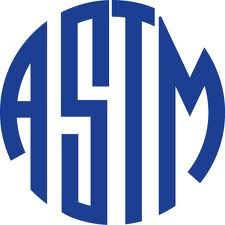
ASTM standards are widely used to define attributes for construction materials and are the standards primarily used in specs. |
|
|
Shop Drawings |
Address the need for more detail from a fabricator or supplier than the specs or drawings can provide. |
|
|
Case Law |

Laws established by the outcome of former cases. |
|
|
Common Law |
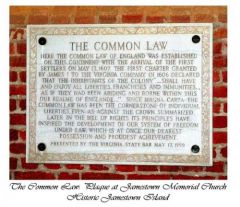
The part of English law that is derived from custom and judicial precedent rather than statutes. Often contrasted with statutory law. |
|
|
Statutory Law |

Term used to define written laws, usually enacted by a legislative body. Statutory laws vary from regulatory or administrative laws that are passed by executive agencies, and common law, or the law created by prior court decisions. |
|
|
Tort Law |

The area of law that covers the majority of all civil lawsuits. Essentially, every claim that arises in civil court with the exception of contractual disputes falls under tort law. The concept of tort law is to redress a wrong done to a person, usually by awarding them monetary damages as compensation. |
|
|
Tort |
A civil or private wrong or injury involving the violation of an individual's private personal rights, causing injury to a person or to property. Often results in a lawsuit. (not criminal) |
|
|
Criminal Law |

A system of law concerned with the punishment of those who commit crimes. |
|
|
Contract |
In common law legal systems, a contract is an agreement having a lawful object entered into voluntarily by two or more parties, each of whom intends to create one or more legal obligations between them. The elements of a contract are "offer" and "acceptance" by "competent persons" having legal capacity who exchange "consideration" to create "mutuality of obligation." |
|
|
Contract Documents |
All documents which, when combined, form the basis of the contract, including all pre-tender, tender and contractual documentation. Your quote can also form part of the contract documentation. The contract documentation will give you sufficient information to be able to complete the building works and meet the service delivery requirements. Includes: Contract, Contract Conditions, Special Contract Conditions, Bill of Quantities, Drawings, Specifications |
|
|
Contract Conditions |
Define the legal rights and obligations, or the rules by which each party (contractor and the owner) must comply. |
|
|
Bond |

An agreement with legal force. |
|
|
Performance Bond |
An approved form of security (money) by the contractor guaranteeing to execute the work in accordance with plans and specs. (bond - an agreement with legal force). Usually issued for 50% of contract price. |
|
|
Payment Bond |
Guarantees that the contractor will pay all bills and obligation for labor and materials incurred under contract (usually at least 50% of contract amount). |
|
|
Bid Bond |
Submitted with the proposal. Guarantees that the bidder will enter into the contract if their proposal is accepted and will furnish payment and performance bonds. |
|
|
Maintenance Bond |
A maintenance bond is not technically insurance, but basically functions as an insurance policy on a construction project to make sure a contractor will either correct any defects that arise or that the owner is compensated for those defects. |
|
|
Change Order |
In project management, a change order is a component of the change management process whereby changes in the Scope of Work agreed to by the Owner, Contractor and Architect/Engineer are implemented. |
|
|
Field Order |
Written instructions for making a minor change in a contract not involving an adjustment to the contract amount or any change in the its completion time. |
|
|
Bill of Quantities |
A list of materials, parts and labour (and their costs) that are included in the contract. The bill of quantities is helpful in valuing variations and assists in the preparation of progress claims |
|
|
Drawings |

The architectural and structural plans of the building. |
|
|
Specifications |
Set out the technical requirements of the work. They describe the project and requirements for materials and workmanship, and add clarity to the drawings |
|
|
Competitive Bid |
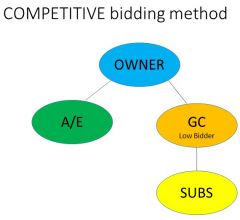
Also known as: hard bid, sealed bid, public bid, lump sum bid. Owner hires A/E. A/E designs and issue CD's. Owner issues RFP from GC's (shortlist) Owner awards to lowest bidder |
|
|
Competitive Sealed Proposal |
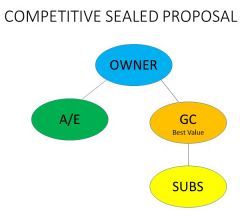
Owner hires A/E. A/E designs and issue CD's. Owner issues RFP from GC's (shortlist) Owner awards to 'best value' |
|
|
Construction Manager-Agent |
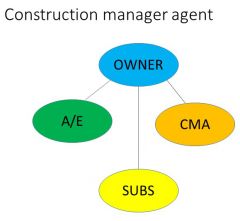
Owner hires A/E and CMA under separate contracts. A/E designes and CMA reps and consults with owner. Owner issues RFP from subs. Owner awards subs offering best value. Owner holds subcontracts and CMA reps owner and manages construction.
|
|
|
Construction Manager at Risk |
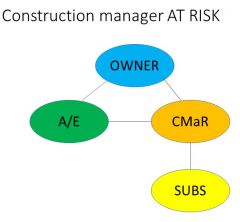
Owner hires A/E and CMaR under separate contracts. A/E designs and CMaR provides pre-con services CMaR issues RFP from subs CMaR holds subcontracts and manages construction |
|
|
Design Build Method |
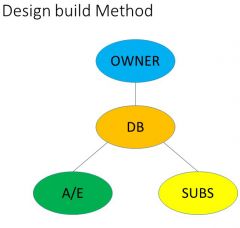
Owner develops design criteria package. Owner hires DB firm in two steps: RFQ then RFP, negotiated procurement Makes decision based on 'best value' DB designs and builds project |
|
|
Professional Liability Insurance |
Claims to protect against injury to persons or damage to property in connection with one's business or premise. |
|
|
Acceleration Cost |
Cost incurred by a contractor when the project is interfered with by the owner, in such a way, that the contractor must employ more manpower or work more hours in order to complete the project on time. If the contractor contributes to the cause of its own delays, acceleration cost may not be granted. |
|
|
ACTUAL DAMAGES – (ACTUAL LOSS) |
damages resulting from real and substantial loss, as opposed to those which are merely theoretical, estimated, or anticipated. Actual damages represent the real and true value of the total loss suffered, as opposed to liquidated damages, which represent an estimated amount calculated as anticipated loss at a future time |
|
|
ADDENDA |
Modifications to the contract documents issued during the bid period. Addenda become official parts of the contract documents and are legally binding to the signatories of the contract. |
|
|
ADVERSARY |
parties to a contract are in an adversary or arms-length relationship to one another as a result of the commitment they have made to each other in the con-tract terms and conditions. This relationship is recognized by the courts and binds the two parties together in that relationship. In layman’s language, it can be considered a relationship of mistrust. |
|
|
AGENT |
A person authorized by another to act for him or her; one who is employed to represent another in business and legal dealings with third persons. In a typical agency relationship, three parties are involved: a principal, an agent, and a third party. The agent represents the principal in dealing with the third party or parties. In the construction industry, a typical misunderstanding is that the LA is the agent to the owner in dealing with the third-party con-tractor. The Landscape Architect, in a typical contract, is the representative of the owner and not of the agent. In some contracts, the construction manager is an agent of the owner. An agency relationship is established in writing (express agency) with all three parties acknowledging the relationship. An agency relationship may also be established by acts and/or omissions of the parties (implied or apparent agency) which will bind the parties legally in the same manner as an expressed agency relationship. |
|
|
ALLOWANCE |
A sum of money set aside by the owner to remove a particular portion of work from competitive bid-ding. This is typical of government-subsidized institutions with work that must be competitively bid and with projects in which certain portions of the work are proprietary and, therefore, must be removed from competitive bidding. |

